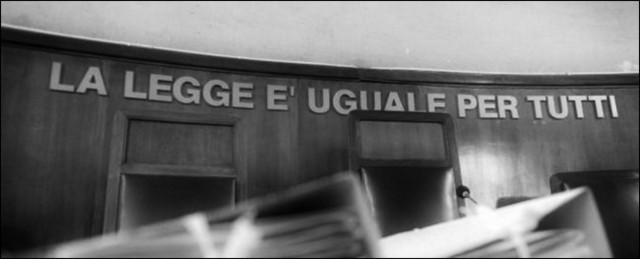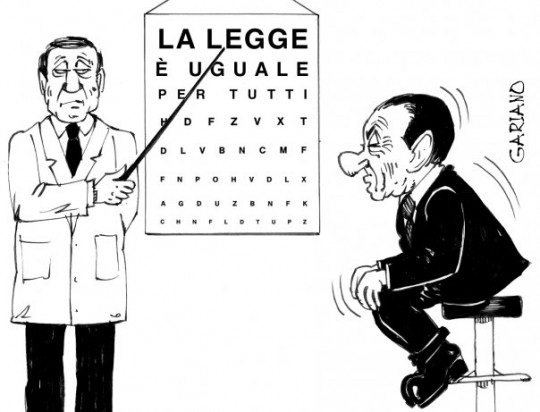… è sempre la stessa storia = it’s always the same old story … study, study, study! Yes my friends, but it’s worth it in the end! So, without further ado, here’s something else for you to study: how do we say ‘the same’ in Italian?
Well, there are three main ways:

1. stesso/i/a/e: the most common adjective used to express the meaning of ‘the same’. Here are some examples of how to use it:
siamo arrivati allo stesso tempo = we arrived at the same time
protezione dell’ambiente e progresso economico non si possono affrontare separatamente, sono due facce della stessa medaglia = environmental protection and economical progress cannot be dealt separately, they are two sides of the same coin
è sempre la stessa storia: ogni nuovo governo aumenta le tasse = it’s the same old story: every new government increases the taxes
continui a fare gli stessi errori tutte le volte = you keep making the same mistakes every time
alla cena c’erano le stesse persone di sempre = at dinner there were the same people as usual

2. uguale/i: means equal, like, identical, and ‘the same’. Let’s have a look at how we use it:
la legge è uguale per tutti = the law is the same for everybody
che tu metta la fetta di limone nella tazza prima o dopo aver versato il tè, il risultato è sempre uguale = whether you put the slice of lemon in the cup before or after pouring the tea, the result is always the same
queste due camicie sono uguali = these two shirts are the same
Giorgio ha comprato due cravatte di uguale colore = Giorgio bought two ties of the same colour
questi due vestiti costano uguale = these two dresses cost the same
N.B. When we are asked to make a choice, we can use either the expression è lo stesso or è uguale, = ‘I don’t mind’ (literally: ‘it’s all the same’), e.g. In gelateria, Mario: “Che gusto preferisci, cioccolato o caffè?” Giulia: “E’ lo stesso/è uguale, scegli tu” = at the ice cream parlour, Mario: “Which flavour do you prefer, chocolate or coffee?” Giulia: “It’s all the same, you choose”

3. medesimo/a/i/e: is more commonly used in written rather than in spoken Italian, but you will occasionally hear people using it. Here are some examples of how we use it:
siamo tornati nel medesimo albergo dell’anno scorso perché ci eravamo trovati molto bene = we went back to the same hotel as last year because we liked it a lot
abbiamo avuto la medesima idea = we’ve had the same idea
continui a fare i medesimi errori tutte le volte = you keep making the same mistakes every time
Mario racconta sempre le medesime barzellette = Mario always tells the same jokes
Alla prossima!


Comments:
Rita:
Carissimi amici’
in quanto alla moda delle nuove calzature,vorrei sapere se con le nuove scarpe si davrebbe comprare una speciale assicurazione e se Serena le usa quando pedala nei dintorni.
Grazie mille per tutti gli interessantissimi blogs. Vi auguro un bel mese autunnale,
Cordialmente,
Rita
Natalia:
I find these entries so very helpful. Grazie!
philippa Davern:
Come si dice in italiano “without further ado”…..ce ne un expression colloquiale??
Serena:
@philippa Davern Salve Philippa, il corrispettivo italiano di “without further ado” è “senza ulteriori indugi”.
Saluti da Serena
Kate:
Thank you very much for this post — I teach Italian in the U.S., and the difference between lo stesso and uguale is something my students often struggle with. If you don’t mind, I have a further question: can you indicate in which of the sentences under number 2 (uguale) it would be possible to substitute stesso? I know you cannot substitute stesso in the third sentence (Queste due camicie sono uguali), because then you would be saying they were actually the same shirt. Any further clarification would be greatly appreciated. And thank you so much for this blog — it’s wonderful!
Serena:
@Kate Salve Kate, you are correct, only number 2 is not interchangeable:
“la legge è uguale per tutti” can be “la legge è la stessa per tutti” (this sounds strange because is a fixed formula, but with la stessa it would be correct)
“che tu metta la fetta di limone nella tazza prima o dopo aver versato il tè, il risultato è sempre uguale” = “… è sempre lo stesso” (perfect match)
“Giorgio ha comprato due cravatte di uguale colore” = “… dello stesso colore” (perfect match)
“questi due vestiti costano uguale” = … costano lo stesso” (ok)
Saluti da Serena
Anne Crawford:
Thank you so much for all the blogs which are always helpful and interesting.
Serena:
@Anne Crawford Grazie Anne e benvenuta!